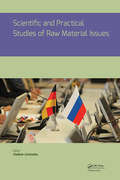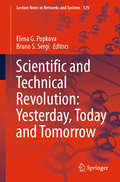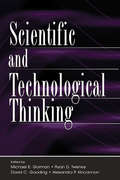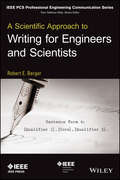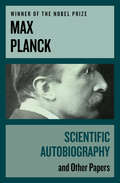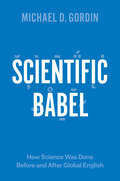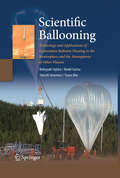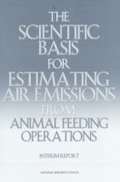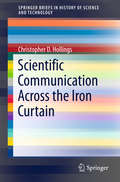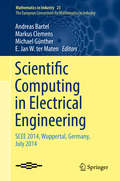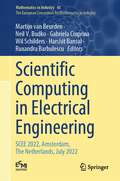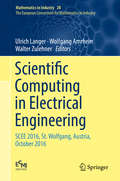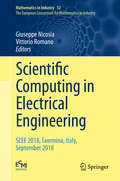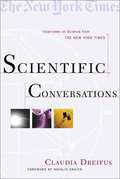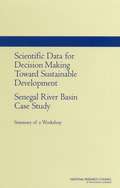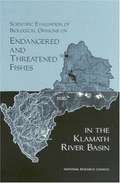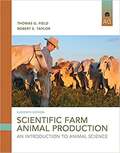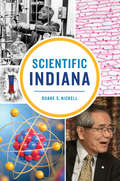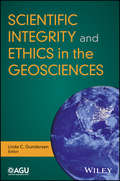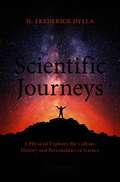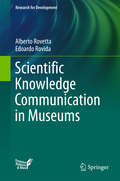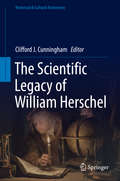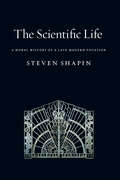- Table View
- List View
Scientific and Practical Studies of Raw Material Issues
by Lucy Richards Vladimir LitvinenkoScientific and practical studies of raw material issues presents the contribution to the Russian-German raw materials forum. The main theme of the book is problematic issues of subsoil use, whereby the contributions are divided in two main parts: - Exploration, mining and processing, and - Mining services Paying much attention to complex processes in the mining industry, Scientific and practical studies of raw material issues will be of interest to academics and professional involved or interested in Mining Engineering and Earth Sciences.
Scientific and Technical Revolution: Yesterday, Today and Tomorrow (Lecture Notes in Networks and Systems #129)
by Elena G. Popkova Bruno S. SergiThis book presents a system view of the digital scientific and technological revolution, including its genesis and prerequisites, current trends, as well as current and potential issues and future prospects. It gathers selected research papers presented at the 12th International Scientific and Practical Conference, organized by the Institute of Scientific Communications. The conference “Artificial Intelligence: Anthropogenic Nature vs. Social Origin” took place on December 5–7, 2019 in Krasnoyarsk, Russia. The book is intended for academic researchers and independent experts studying the social and human aspects of the Fourth Industrial Revolution and the associated transition to the digital economy and Industry 4.0, as well as the creators of the legal framework for this process and its participants – entrepreneurs, managers, employees and consumers. It covers a variety of topics, including “intelligent” technologies and artificial intelligence, the digital economy, the social environment of the Fourth Industrial Revolution and its consequences for humans, the regulatory framework of the Fourth Industrial Revolution, and the “green” consequences, prospects and financing of the Fourth Industrial Revolution.
Scientific and Technological Thinking
by Michael E. Gorman Ryan D. Tweney David C. Gooding Alexandra P. KincannonAt the turn of the 21st century, the most valuable commodity in society is knowledge--particularly new knowledge that may give a culture, company, or laboratory an adaptive advantage. Knowledge about the cognitive processes that lead to discovery and invention can enhance the probability of making valuable new discoveries and inventions. Such knowledge needs to be made widely available to ensure that no particular interest group "corners the market" on techno-scientific creativity. Knowledge can also facilitate the development of business strategies and social policies based on a genuine understanding of the creative process. Furthermore, through an understanding of principles underlying the cognitive processes related to discovery, educators can utilize these principles to teach students effective problem-solving strategies as part of their education as future scientists.This book takes the reader out onto the cutting edge of research in scientific and technological thinking. The editors advocate a multiple-method approach; chapters include detailed case studies of contemporary and historical practices, experiments, computational simulations, and innovative theoretical analyses. The editors attempt a provocative synthesis of this work at the end.In order to achieve true scientific and technological progress, an understanding of the process by which species are transforming the world is needed. This book makes an important step in that direction by leading to breakthroughs in the understanding of discovery and invention.
A Scientific Approach to Writing for Engineers and Scientists (IEEE PCS Professional Engineering Communication Series)
by Robert E. BergerA SCIENTIFIC APPROACH TO WRITING Technical ideas may be solid or even groundbreaking, but if these ideas cannot be clearly communicated, reviewers of technical documents—e.g., proposals for research funding, articles submitted to scientific journals, and business plans to commercialize technology—are likely to reject the argument for advancing these ideas. The problem is that many engineers and scientists, entirely comfortable with the logic and principles of mathematics and science, treat writing as if it possesses none of these attributes. The absence of a systematic framework for writing often results in sentences that are difficult to follow or arguments that leave reviewers scratching their heads. This book fixes that problem by presenting a “scientific” approach to writing that mirrors the sensibilities of scientists and engineers, an approach based on an easily-discernable set of principles. Rather than merely stating rules for English grammar and composition, this book explains the reasons behind these rules and shows that good reasons can guide every writing decision. This resource is also well suited for the growing number of scientists and engineers in the U.S. and elsewhere who speak English as a second language, as well as for anyone else who just wants to be understood.
Scientific Autobiography: And Other Papers
by Max PlanckIn this fascinating autobiography from one of the foremost geniuses of twentieth-century physics, Max Planck tells the story of his life, his aims, and his thinking. Published posthumously, the papers in this volume were written for the general reader and make accessible Planck&’s scientific theories as well as his philosophical ideals, including his thoughts on ethics and morals.
Scientific Autobiography: And Other Papers
by Max PlanckIn this fascinating autobiography from one of the foremost geniuses of twentieth-century physics, Max Planck tells the story of his life, his aims, and his thinking. Published posthumously, the papers in this volume were written for the general reader and make accessible Planck&’s scientific theories as well as his philosophical ideals, including his thoughts on ethics and morals.
Scientific Babel: How Science Was Done Before and After Global English
by Michael D. GordinEnglish is the language of science today. No matter which languages you know, if you want your work seen, studied, and cited, you need to publish in English. But that hasn’t always been the case. Though there was a time when Latin dominated the field, for centuries science has been a polyglot enterprise, conducted in a number of languages whose importance waxed and waned over time--until the rise of English in the twentieth century. So how did we get from there to here? How did French, German, Latin, Russian, and even Esperanto give way to English? And what can we reconstruct of the experience of doing science in the polyglot past? With Scientific Babel, Michael D. Gordin resurrects that lost world, in part through an ingenious mechanism: the pages of his highly readable narrative account teem with footnotes--not offering background information, but presenting quoted material in its original language. The result is stunning: as we read about the rise and fall of languages, driven by politics, war, economics, and institutions, we actually see it happen in the ever-changing web of multilingual examples. The history of science, and of English as its dominant language, comes to life, and brings with it a new understanding not only of the frictions generated by a scientific community that spoke in many often mutually unintelligible voices, but also of the possibilities of the polyglot, and the losses that the dominance of English entails. Few historians of science write as well as Gordin, and Scientific Babel reveals his incredible command of the literature, language, and intellectual essence of science past and present. No reader who takes this linguistic journey with him will be disappointed.
Scientific Ballooning: Technology and Applications of Exploration Balloons Floating in the Stratosphere and the Atmospheres of Other Planets
by Naoki Izutsu Toyoo Abe Nobuyuki Yajima Takeshi ImamuraThe aim of this book is to introduce scientific ballooning to the many people who are interested in the use of balloons for scientific applications. The book offers a basic understanding of the engineering details and the scientific research giving rise to balloon activities going on today. Above all, the book will serve as a guidebook for young scientists and researchers seeking to become involved in space science and technology by participating in balloon projects. The book deals with three types of balloons: large stratospheric balloons used for scientific purposes, rubber balloons used for aerological observations, and planetary balloons to be used in the atmospheres of other planets. The book provides many figures and photographs, and offers a systematic description of balloon technologies and related matters from historical background to current research topics. The contents include a theoretical discussion of ballon shape design, analysis and synthesis of flight dynamics, actual launching procedure, flight operations, and typical applications of ballooning in various scientific fields. Detailed meteorological descriptions, especially of the Earth's stratosphere and the atmosphere of other planets, are provided for investigating actual flight behavior.
The Scientific Basis for Estimating Air Emissions from Animal Feeding Operations
by Ad Hoc Committee on Air Emissions from Animal Feeding OperationsThis is an interim report of the Ad Hoc Committee on Air Emissions from Animal Feeding Operations of the National Research Council's Committee on Animal Nutrition. The report focuses on identifying the scientific criteria needed to ensure that estimates of air emission rates are accurate, examining the basis for these criteria in the scientific literature, and assessing uncertainties associated with them. There is no subject index. Annotation (c)2003 Book News, Inc. , Portland, OR (booknews. com)
Scientific Communication Across the Iron Curtain
by Christopher D. HollingsThis monograph provides a concise introduction to the tangled issues of communication between Russian and Western scientists during the Cold War. It details the extent to which mid-twentieth-century researchers and practitioners were able to communicate with their counterparts on the opposite side of the Iron Curtain. Drawing upon evidence from a range of disciplines, a decade-by-decade account is first given of the varying levels of contact that existed via private correspondence and conference attendance. Next, the book examines the exchange of publications and the availability of one side's work in the libraries of the other. It then goes on to compare general language abilities on opposite sides of the Iron Curtain, with comments on efforts in the West to learn Russian and the systematic translation of Russian work. In the end, author Christopher Hollings argues that physical accessibility was generally good in both directions, but that Western scientists were afflicted by greater linguistic difficulties than their Soviet counterparts whose major problems were bureaucratic in nature. This volume will be of interest to historians of Cold War science, particularly those who study communications and language issues. In addition, it will be an ideal starting pointing for anyone looking to know more about this fascinating area.
Scientific Computing in Electrical Engineering
by Andreas Bartel Markus Clemens Michael Günther E. Jan W. ter MatenThis book is a collection of selected papers presented at the 10thInternational Conference on Scientific Computing in Electrical Engineering(SCEE), held in Wuppertal, Germany in 2014. The book is divided into fiveparts, reflecting the main directions of SCEE 2014: 1. Device Modeling,Electric Circuits and Simulation, 2. Computational Electromagnetics, 3. CoupledProblems, 4. Model Order Reduction, and 5. UncertaintyQuantification. Each part starts with a general introduction followed bythe actual papers. The aim of the SCEE 2014 conference was to bring together scientistsfrom academia and industry, mathematicians, electrical engineers, computerscientists, and physicists, with the goal of fostering intensive discussions onindustrially relevant mathematical problems, with an emphasis on the modelingand numerical simulation of electronic circuits and devices, electromagneticfields, and coupled problems. The methodological focus was on model orderreduction and uncertainty quantification.
Scientific Computing in Electrical Engineering: SCEE 2022, Amsterdam, The Netherlands, July 2022 (Mathematics in Industry #43)
by Martijn Van Beurden Neil V. Budko Gabriela Ciuprina Wil Schilders Harshit Bansal Ruxandra BarbulescuThis volume comprises selected papers presented at the 14th International Conference on Scientific Computing in Electrical Engineering, SCEE 2022, held in Amsterdam, The Netherlands, in July 2022. The aim of the SCEE 2022 conference was to bring together scientists – mathematicians, electrical engineers, computer scientists, and physicists, from universities and industry – to have in-depth discussions of the latest scientific results in Computational Science and Engineering relevant to Electrical Engineering and to stimulate and inspire active participation of young researchers.This extensive reference work is divided into four parts: Part I Circuit Simulation and Design.- Part II Device Simulation.- Part III Computational Electromagnetics.- Part IV Mathematical and Computational Methods. Each part starts with a general introduction, followed by the respective contributions. The book will appeal to mathematicians and electricalengineers. Further, it introduces algorithm and program developers to recent advances in the other fields, while industry experts will be introduced to new programming tools and mathematical methods.
Scientific Computing in Electrical Engineering: Scee 2016, St. Wolfgang, Austria, October 2016 (Mathematics In Industry Ser. #28)
by Ulrich Langer Wolfgang Amrhein Walter ZulehnerThis collection of selected papers presented at the 11th International Conference on Scientific Computing in Electrical Engineering (SCEE), held in St. Wolfgang, Austria, in 2016, showcases the state of the art in SCEE. The aim of the SCEE 2016 conference was to bring together scientists from academia and industry, mathematicians, electrical engineers, computer scientists, and physicists, and to promote intensive discussions on industrially relevant mathematical problems, with an emphasis on the modeling and numerical simulation of electronic circuits and devices, electromagnetic fields, and coupled problems. The focus in methodology was on model order reduction and uncertainty quantification. This extensive reference work is divided into six parts: Computational Electromagnetics, Circuit and Device Modeling and Simulation, Coupled Problems and Multi‐Scale Approaches in Space and Time, Mathematical and Computational Methods Including Uncertainty Quantification, Model Order Reduction, and Industrial Applications. Each part starts with a general introduction, followed by the respective contributions. This book will appeal to mathematicians and electrical engineers. Further, it introduces algorithm and program developers to recent advances in the other fields, while industry experts will be introduced to new programming tools and mathematical methods.
Scientific Computing in Electrical Engineering: SCEE 2018, Taormina, Italy, September 2018 (Mathematics in Industry #32)
by Giuseppe Nicosia Vittorio RomanoThis collection of selected papers presented at the 12th International Conference on Scientific Computing in Electrical Engineering, SCEE 2018, held in Taormina, Sicily, Italy, in September 2018, showcases the state of the art in SCEE.The aim of the SCEE 2018 conference was to bring together scientists from academia and industry, mathematicians, electrical engineers, computer scientists, and physicists, and to promote intensive discussions on industrially relevant mathematical problems, with an emphasis on the modeling and numerical simulation of electronic circuits and of electromagnetic fields. This extensive reference work is divided into five parts: Computational Electromagnetics, Device Modeling and Simulation, Circuit Simulation, Mathematical and Computational Methods, Model Order Reduction. Each part starts with a general introduction, followed by the respective contributions. The book will appeal to mathematicians and electrical engineers. Further, it introduces algorithm and program developers to recent advances in the other fields, while industry experts will be introduced to new programming tools and mathematical methods.
Scientific Conversations: Interviews on Science from the New York Times
by Claudia DreifusDr. Benjamin Carson, a pediatric neurosurgeon, describes what it feels like to dig around in someone's brain. Dr. Leon Lederman, Nobel laureate, displays the wry humor that has earned him the title :the Mel Brooks of the physics world. : Pulitzer Prize-winning author John McPhee reveals how he cam to terms with the vastness of geological time and that he once tied himself to a chair in order to write. Ira Flatow, host of National Public Radio's Science Friday, recalls how his childhood fascination with electrical outlets almost caused him to blow up his mother's bathroom. Astronomer Royal Sir Martin Rees discloses his astrological sign. In these thirty-eight interviews, originally published in the weekly Science Times section of The New York Times, Claudia Dreifus brings all of her colorful personality to bear on her subjects, as well as an arsenal of philosophy, literature, current events, and an unmistakable curiosity. As each conversation unfolds, we learn surprising and fascinating things about some of the most intriguing figures and issues in science today. Dreifus's outsider status in the world of science is perhaps one of her greatest interviewing strengths. A political journalist for much of her career, she stumbled into a position at the Science Times. With little more scientific background that the average person, she scrambled to prepare for her meetings with some of the greatest minds across a broad range of disciplines-from astronomy to geology, from biology and medicine to computer science and mathematics. She soon found herself in a refreshingly candid environment, so unlike the one she had known on the political beat. It is from this perspective that she makes science tangible, accessible, and entertaining. When you add a deep-rooted scientific curiosity to the savvy of a crack political reporter, you get more than just extraordinary chemistry: Claudia Dreifus reminds us that interviewing can be an art form.
Scientific Data for Decision Making Toward Sustainable Development: Senegal River Basin Case Study
by U.S. National Committee for CODATAScientific databases relating to the environment, natural resources, and public health on the African continent are, for various reasons, difficult to create and manage effectively. Yet the creation of these and other types of databases--and their subsequent use to produce new information and knowledge for decision-makers--is essential to advancing scientific and technical progress in that region and to its sustainable development. The U.S. National Committee for CODATA collaborated with the Senegalese National CODATA Committee to convene a "Workshop on Scientific Data for Decision-Making Toward Sustainable Development: Senegal River Basin Case Study," which was held on 11-15 March 2002, in Dakar, Senegal. The workshop examined multidisciplinary data sources and data handling in the West Africa region, using the Senegal River Basin as a case study, to determine how these data are or can be better used in decision making related to sustainable development.
Scientific Evaluation Of Biological Opinions On Endangered And Threatened Fishes In The Klamath River Basin: Interim Report
by Committee on Endangered Threatened Fishes in the Klamath River BasinA report on Scientific Evaluation Of Biological Opinions On Endangered And Threatened Fishes In The Klamath River Basin
Scientific Farm Animal Production: An Introduction
by Thomas Field Robert TaylorWith Scientific Farm Animal Production, students of animal agriculture get a comprehensive, science-based approach to building livestock and poultry management systems for food, fiber, and recreation. It effectively integrates the scientific disciplines that support livestock and poultry production with detailed information about the primary livestock species, appropriate management protocols, and the market forces that impact demand across the supply chain. As a result of a comprehensive review by nearly 20 professionals, this new edition features increased clarity, depth and accuracy, including improved end-of-chapter questions; updated and enhanced figures and color photos; the latest demographic data; an expanded discussion of social and consumer issues; and an authoritative look at the trends, issues, and opportunities for animal agriculture.
Scientific Foundations of Engineering
by Mcknight Stephen W. Christos ZahopoulosProviding an overview of the foundations of engineering from a fundamental scientific and physical perspective, this book reinforces the basic scientific and mathematical principles which underpin a range of engineering disciplines and applications. It covers the basics of physics, including quantum physics, as well as some key topics in chemistry, making it a valuable resource for both students and professionals looking to gain a more coherent and interdisciplinary understanding of engineering systems. Throughout, the focus is on common features of physical systems (such as mechanical and electronic resonance), showing how the same underlying principles apply to different disciplines. Problems are provided at the end of each chapter including conceptual questions and examples to demonstrate the practical application of fundamental scientific principles. These include real-world examples, which are solvable using computational packages such as MATLAB.
Scientific Indiana
by Duane S. NickellScientists who lived, worked or were educated in the Hoosier State have made fundamental contributions to astronomy, biology, chemistry and physics. Astronomer Vesto Slipher discovered that almost all other galaxies were moving away from our own Milky Way Galaxy. Biologist Alfred Kinsey was a pioneer in the field of human sexuality. Chemist Harold Urey discovered deuterium and worked on the Manhattan Project. And physicist Edward Purcell discovered nuclear magnetic resonance, the basis for MRI, one of the most significant medical advances in a century. Scientists with Indiana connections have also been awarded a dozen Nobel Prizes. Hoosier science teacher Duane S. Nickell offers a glimpse into the lives of seventeen scientific heroes from Indiana.
Scientific Integrity and Ethics in the Geosciences
by Linda C. GundersenScience is built on trust. The assumption is that scientists will conduct their work with integrity, honesty, and a strict adherence to scientific protocols. Written by geoscientists for geoscientists, Scientific Integrity and Ethics in the Geosciences acquaints readers with the fundamental principles of scientific ethics and shows how they apply to everyday work in the classroom, laboratory, and field. Resources are provided throughout to help discuss and implement principles of scientific integrity and ethics. Volume highlights include: Examples of international and national codes and policies Exploration of the role of professional societies in scientific integrity and ethics References to scientific integrity and ethics in publications and research data Discussion of science integrity, ethics, and geoethics in education Extensive coverage of data applications Scientific Integrity and Ethics in the Geosciences is a valuable resource for students, faculty, instructors, and scientists in the geosciences and beyond. It is also useful for geoscientists working in industry, government, and policymaking.
Scientific Journeys: A Physicist Explores the Culture, History and Personalities of Science
by H. Frederick DyllaThis collection of essays traces a scientific journey bookmarked by remarkable mentors and milestones of science. It provides fascinating reading for everyone interested in the history, public appreciation, and value of science, as well as giving first-hand accounts of many key events and prominent figures. The author was one of the “sputnik kids” growing up in the US at the start of the space age. He built a working laser just two years after they were first invented, an experience that convinced him to become a physicist. During his 50-year career in physics, many personalities and notable events in science and technology helped to form his view of how science contributes to the modern world, including his conviction that the impact of science can be most effective when introduced within the context of the humanities - especially history, literature and the arts.From the Foreword by former U.S. Congressman, Rush D. Holt: In this volume, we have the wide-ranging thoughts and observations of Fred Dylla, an accomplished physicist with an engineer’s fascination for gadgets, a historian’s long perspective, an artist’s aesthetic eye, and a teacher’s passion for sharing ideas. Throughout his varied career [...] his curiosity has been his foremost characteristic and his ability to see the connection between apparently disparate things his greatest skill. [...] Here he examines the roots and growth of innovation in examples from Bell Laboratories, Edison Electric Light Company, and cubist painter Georges Braque. He considers the essential place of publishing in science, that epochal intellectual technique for learning how the world works. He shows the human enrichment and practical benefits that derive from wise investments in scientific research, as well as the waste resulting from a failure to embrace appropriate technologies.
Scientific Knowledge Communication in Museums (Research For Development Ser.)
by Alberto Rovetta Edoardo RovidaThis book explains the general principles of scientific and technical communication in the context of modern museums. It also examines, with the aid of informative case studies, the different means by which knowledge can be transmitted, including posters, objects, explanatory guidance, documentation, and catalogues. Highlighting the ever more important role of multimedia and virtual reality components in communicating understanding of and facilitating interaction with the displayed object, it explores how network communications systems and algorithms can be applied to offer individual users the information that is most pertinent to them. The book is supported by a Dynamic Museums app connected to museum databases where series of objects can be viewed via cloud computing and the Internet and printed using 3D printing technology. This book is of interest to a diverse readership, including all those who are responsible for museums’ collections, operations, and communications as well as those delivering or participating in courses on museums and their use, communication design and related topics.
The Scientific Legacy of William Herschel
by Clifford J. CunninghamThis book presents a modern scholarly analysis of issues associated with England'smost famous astronomer, William Herschel. The world's leading experts onHerschel, discoverer of the planet Uranus, here offer their combined wisdom on manyaspects of his life and astronomical research. Solar system topics includecomets, Earth's Moon, and the spurious moons of Uranus, all objects whose observation was pioneered by Herschel. The contributors examine his study of thestructure of the Milky Way and an in-depth look at the development of the front view telescopes he built. The popular subject of extraterrestriallife is looked at from the point of view of both William Herschel and his sonJohn, both of whom had an interest in the topic. William's personal development through the educational system of the lateeighteenth-century is also explored, and the wide range of verse and satire invarious languages associated with his discoveries is collected here for thefirst time. Hershel worked at a time of incredible discovery, and his work is still highly regarded in the field. Here it is given a thorough investigation which puts into context and perspective his path breaking career.
The Scientific Life: A Moral History of a Late Modern Vocation
by Steven ShapinConventional wisdom has long held that scientists are neither better nor worse than anyone else, that personal virtue does not necessarily accompany technical expertise, and that scientific practice is profoundly impersonal. Shapin, however, here shows how the uncertainties attending scientific research make the virtues of individual researchers intrinsic to scientific work. Further, Shapin argues that the radical uncertainties of much of contemporary science have made personal virtues more central to its practice than ever before, and he also reveals how radically novel aspects of late modern science have unexpectedly deep historical roots.
